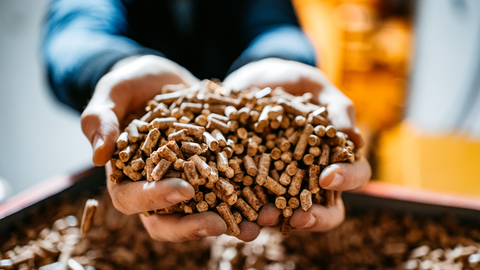If you live in a cold climate, then you are probably aware of the costs that go into keeping your space comfortable.
These heating expenses can be a significant concern for both home and business owners alike, especially in the coldest winter months. While many choose to offset their high heating bills by supplementing their space with cost-effective additional units, such as heating stoves, there still remains the question of what kind of heating fuel is most economical and the best fit for you and your home.
To help you make an informed decision, we will compare various aspects of oil and pellet heating, including their efficiency, environmental impact and expenses.
What is Pellet Fuel?
Pellet fuel is a type of biomass fuel made by compressing organic material, like sawdust, wood chips or agricultural waste, then processing the material and forming it into small, uniform pellets. The pellets are meant to be used in specially designed pellet stoves or fireplace inserts, which are specifically engineered to efficiently and cleanly burn the fuel to heat the interior of a building.
Pellets are a very popular source of supplemental heating due to their cost-effectiveness, effortless cleanup and ease of use. Users simply feed the pellets into the hopper located on the top of the stove and the fuel is funneled into the firebox for a no-fuss, convenient heating solution.
What is Heating Oil?
Mainly used as a heating fuel in the northeastern United States, heating oil is a non-renewable resource derived from petroleum that is burned in furnaces and oil-fired boilers.
Heating with oil comes with its downsides. Oil is expensive, especially in contrast to sustainable biomass alternatives such as wood and pellets. Unlike biomass fuels, which are normally unchanged by the fluctuation of the economy, oil experiences extreme price volatility.
Furthermore, the “combustion of heating oil contributes to air pollution, global warming, and climate change” according to the Connecticut Council on Environmental Quality. Oil is linked to negative impacts on the environment—specifically, wildlife, water and the atmosphere—and human health.
Is Heating with Pellets Cheaper than Oil?
Generally, yes. While the price of wood pellets can vary by location and manufacturer, they usually cost less than heating oil, especially since oil experiences volatility in price. Not only are pellets cheaper, but they burn much more efficiently and consistently than oil.
3 Tips for Increasing Your Home’s Heating Efficiency
In addition to a cost-effective and sustainable pellet stove, there are several other ways to increase your home or business’s heating efficiency and optimize your energy consumption to keep even more money in your pocket. Here are a few:
Zone Heating
Utilizing the zone heating method in your home allows you to heat specific areas of your home as needed and avoid wasting energy to heat spaces that are not being used. Simply close off unused rooms to keep the warm air in the areas where you spend the most time.
Home Energy Audit
Conducting a home energy audit can help you identify areas of inefficiency in your space. Home energy audits are usually offered by local energy companies to evaluate the efficiency of your home. Leaks, broken windows, poor insulation and damaged weatherstripping or caulking can be sources of heat loss that waste fuel and cost you money.
High-Efficiency Heater
Upgrading to a high-efficiency pellet stove or insert can maximize your heat output, minimize your energy consumption and not only lower the cost of your heating bills, but mitigate your environmental impact as well.
To learn more about how to boost heating efficiency, visit our blog, Five Ways to Winterize Your Home.
Using Pellets to Efficiently Heat Your Home

In order to efficiently heat your home with a pellet stove there are a few factors to consider:
Location — The availability of pellets can vary depending on where you are in the world. In North America, you can often find them in specialty hearth stores and farm stores, such as Tractor Supply.
Installation — Properly installing your pellet heating system is crucial for both efficiency and effectiveness and is a job that requires professional expertise. A correctly installed, strategically placed pellet heating unit will perform better and ensure optimal heating. To find an installer near you, visit our Find a Dealer page.
Technology — Modern pellet stoves featuring the latest updates and innovations, will always outperform and be more efficient than older, out dated models.
5 Benefits of Heating with a Pellet Stove or Insert
The benefits of a pellet stove or insert are numerous, but here are five of our favorites:
- Cost Savings — Heating with a pellet stove or insert can save you money on your utility bills, especially compared to oil, gas or electricity.
- Sustainability — Pellets are a renewable fuel source and absorb nearly as much carbon as they give off when burned.
- Efficiency — Pellet products sold in the U.S. are EPA-certified to meet specific qualifications for emissions and efficiency. Harman and Quadra-Fire stoves, in particular, are so efficient there’s very little ash to clean up afterward.
- Dependability — Pellet stoves are highly reliable and long lasting. When properly maintained, a stove can last between 10–20 years before needing to be replaced.
- Engineering Excellence — Forge & Flame products are built to meticulous standards. The exclusive features on Harman and Quadra-Fire stoves and inserts are designed for quick and easy maintenance, durability and optimal heat output.
Where Can I Buy a Pellet Stove?
If you’ve been convinced by the convenience and cost-saving features of pellet fuel, then you’re in the right place.
Forge & Flame pellet stoves and inserts are the perfect blend of performance and engineering excellence. As the leading manufacturer of premium pellet stoves and inserts, we are confident that our energy-efficient, exclusive products can provide you the supplemental heat you need while saving money and energy.
Follow the link to find a Forge & Flame pellet stove dealer near you.


